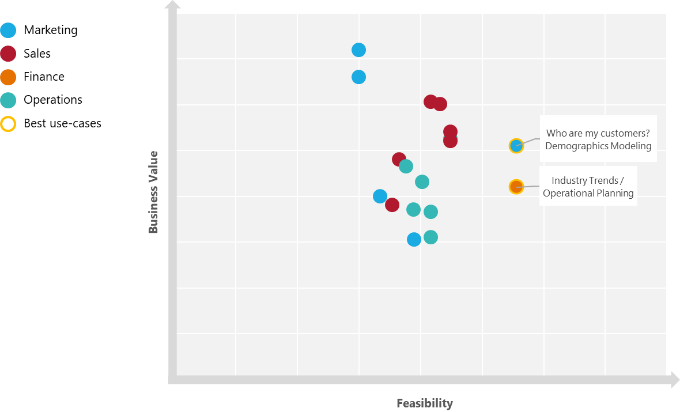The development of artificial intelligence (AI) is well on its way. Promising use cases are featured prominently in the news, and there are abundant opportunities for AI in every industry.
AI really does introduce disruptive possibilities. The question is not if you need to incorporate it into your organization, but rather when, how, and where.
And that’s where a lot of companies struggle: Where do you start and how do you grow? Which use cases should you tackle first? Are you too late to get started?
As a relatively new phenomenon, it’s difficult for executives to understand how to wield AI’s power to benefit the business’ bottom line. This article walks through how we approach these questions.
Before going into more detail, let’s discuss two of Keyrus’ guiding beliefs with respect to AI. These beliefs heavily influence our advised approach.
The potential impact of AI is immense. As such, the focal point of AI application should lie in the creation of value, not the reduction of costs. It’s easy to think of applying robotics to reduce processing time, but the revolutionary value of AI comes into play in developing new products and untapped markets.
Change will be rapid and frequent. A great AI strategy allows for drastic change. Each impact horizon (from short-term to long-term) requires a different approach and attitude. A diversified approach will help you deal with whatever AI is going to throw at you.
Optimization, Goals, and Cooperation
Artificial intelligence mimics nature. For centuries, humans have drawn inspiration from nature. From our desire to fly to the more peculiar invention of Velcro, nature has always driven our imagination.
We can look to nature for inspiration in taking artificial intelligence to the next level as well. This advice is applicable not only for AI itself, but also for the development of the AI capability within the organization. And since we always talk about the “path” to an end result when discussing development, why not draw our inspiration from exactly that: paths and trails in nature?
Robert Moor’s On Trails is a great book on how paths and trails form, why some improve over time, and why others fade. I noticed that the why and how of the creation of trails provide great insight on optimization, the value of objectives, and how cooperation can get you where you need to be more quickly.
In essence, a path or trail is something that connects where you are now to where you want to go. And since that's exactly what building an AI capability is about, these insights are great ways to explain our approach to AI development.
Let’s look at a few examples from the book.
The first example highlights how ants – intentionally or not – create efficient trails:
He (Richard Feynman) was curious to find out why ant trails inevitably ‘’look so straight and nice.’’ First, he placed a lump of sugar on the far side of the bathtub and waited for hours until an ant found it. Then, Feynman picked up a colored pencil and traced the ant’s return path along the bathtub. The resulting trail was ‘’quite wiggly,’’ full of errors.
Another ant emerged, followed the first ant’s trail, and located the sugar. But in its haste to return with its bounty, the second ant repeatedly lost the first ant’s trail, cutting off many of the unnecessary curves: the second line was noticeably straighter than the first. He ultimately followed as many as ten ants with his pencils, and, as he’d expected, the last few trails he traced formed a neat line along the bathtub’s edge.
He also discusses the purpose of elephant trails:
“Lo and behold,” Blake said, “just like all the footpaths in England lead to either the pub or the church, all elephant trails tend to lead to something that elephants want to get to.”
A third example highlights a story about a small group of zebras that reached an area of land with the help of these elephant trails, which they likely never would have reached on their own:
“Through a series of exploratory walks, the zebras might have followed a chain of elephant trails that led them from water source to water source all the way to the salt flats.”
What is the key takeaway from these examples? In summary:
“Every trail is, in essence, a best guess: An ant does not leave a strong pheromone trail unless it has found food, which means that it has already made a correct calculation of where the food is. The same rule applies to humans – we generally don’t make trails unless there is something on the other end worth reaching. It’s only once an initial best guess is made, and others follow it, that a trace begins to evolve into a trail.”
If you look at what these stories tell us, you see that:
The first attempt needs to be right, but not perfect. It’s more important to get started and ensure that your first endeavor succeeds. You optimize by experimenting, diverging, and continuously improving.
To get somewhere, you need to understand where you want to go. Without a goal in mind, it is difficult to get where you need to be. Unfortunately, unlike ants, pheromones won’t help us in guiding our strategic decisions. However, we’re blessed with the ability to reason, strategize, and plan. Failing to plan is planning to fail.
Experimentation pays off in the long term. An inherent aspect of experimentation is that some efforts fail. In nature, this means that valuable trails solidify, whereas worthless trails fade over time. The same holds true for approaches in business; the ones that do succeed provide more than enough value to make up for it.
Cooperation fuels success. Others may have already gathered significant knowledge or laid down the groundwork. Learn from them and cooperate with them. It will take you further than you would have gone on your own.
Different objectives result in different paths. Your approach should be tailored to what you want to achieve. To get to a temporary food source, a more rudimentary trail suffices, but an essential year-round water source requires a solid path.
Our Approach to Developing AI Capabilities
Our general approach to developing AI capabilities is founded in our guiding beliefs and also reflects the insights above. One of the defining elements in our approach reflects the last lesson: each impact horizon has its own approach.
Let’s look at each of these separately.

Short-term impact: Create momentum
Achieving results is important for the short-term, but gaining momentum is most important. Once again, it’s important to be right, but the first try doesn’t need to be perfect. We want to ensure that the company gets acquainted with data science, learns how to deliver use cases, and increases the visibility of AI across the organization.
One of the first steps often entails identifying and prioritizing use cases and turning these into proofs of concept (POCs). Using our knowledge and company-specific input (for example, through an executive education workshop), we create a short list of use cases. These cases get scored on business value and required effort and are prioritized accordingly. This often results in use cases that leverage what your organization already has. This minimizes up-front investment and ensures in-house knowledge buildup. An example of use case selection looks like this:

After the selection of the right use case, we do everything to ensure the POC succeeds. We create a short-term plan and guarantee that the right skills, tools, executive support, data, and people are in place to reach the desired goal.
Medium-term impact: Plan ahead
We often see that organizations lack a plan when it comes to growing their AI capability. Where a single or smaller set of use cases can guide our actions on the short-term, for medium-term impact, we need a more comprehensive approach that builds on these first initiatives.
We create a comprehensive roadmap that not only addresses technical challenges, but also looks at the required changes within aspects such as governance, skills, processes, data and information, and architecture.
Long-term impact: Experiment
On the longer-term, things are less clear; in AI, things are bound to change. Believing that experimentation will pay off over time, a part of your organization should engage with the latest trends, newest techniques, and latest changes in the world of AI. By remaining at the forefront of these changes, when things do drastically change, you will be prepared and ahead of the curve. If you don’t keep up, you’ll end up back to the first steps that we’ve highlighted.
Of course, the right approach for your company is governed by much more than what we can discuss here. We could dedicate entire articles to the right choice of technology and tools, and how your governance might change to adapt to the new reality.
However, we believe that if you do these three essential steps correctly, you’re well on your way to creating a viable and scalable artificial intelligence capability within your organization, both now, and in the long term.
What’s Next?
If you have goals in mind but you’re not sure how to get started with a data analytics practice at your organization, check out our Data Lifecycle and Analytics in the Cloud e-Book. This eBook will guide you through five stages of the data lifecycle and prepare you to optimize or establish advanced analytics and AI.
